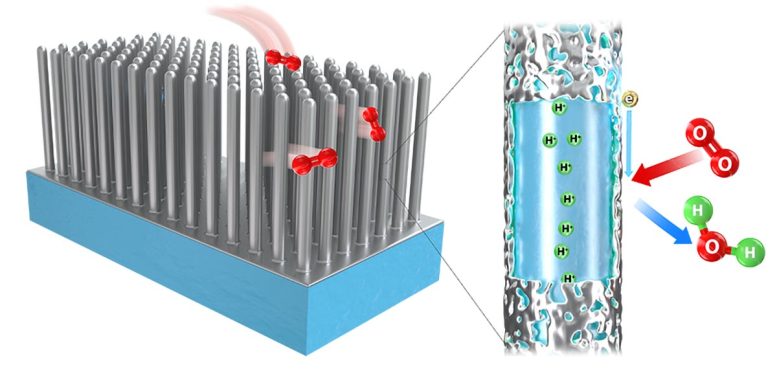
Vertically aligned coaxial nanowires in an electrode with protons transported in the ionomer core inside the nanowire. Electrons transported in the platinum nanofilm shell combine with oxygen to complete the fuel cell cathode reaction. Credit LANL
The Los Alamos National Laboratory introduced a corrosion-resistant fuel cell design featuring a coaxial nanowire electrode. This innovative approach holds promise for heavy-duty trucking, showing impressive durability in stress tests.
A groundbreaking fuel cell design offers potential advancements for heavy-duty trucking and various other clean fuel cell applications. A promising, more durable fuel cell design could help transform heavy-duty trucking and other clean fuel cell applications. Consisting of nanowires that are less susceptible to corrosion than other designs, the innovative electrode — the heart of a polymer electrolyte-membrane fuel cell — could usher in a new era for fuel cells, which use hydrogen as emission-free power for vehicles.
“In real-world terms, this means that we can have a more durable fuel cell that will provide high fuel economy over a longer lifetime,” said Jacob Spendelow, a scientist with the Los Alamos National Laboratory team that described its results in the journal Advanced Materials. “This work demonstrates that we can get rid of conventional carbon-based catalyst supports, eliminating the degradation problems associated with carbon corrosion, while still achieving high fuel cell performance.”
Application in Heavy-Duty Trucking
The enhanced durability makes this fuel cell a promising candidate for use in heavy-duty trucking applications, where fuel cell longevity exceeding 25,000 hours is essential.
The coaxial nanowire electrode (CANE) consists of an array of vertically aligned nanowires in which each nanowire comprises a catalytically active platinum film surrounding an ion-conducting polymer core. By avoiding carbon-based catalyst supports, the CANE eliminates common degradation mechanisms associated with carbon corrosion.
Performance and Durability Tests
To evaluate the new fuel cell’s durability, the team at Los Alamos National Laboratory conducted accelerated stress tests. Remarkably, the CANE lost a mere 2% of its performance after undergoing 5,000 stress test cycles targeting the support materials. In contrast, a traditional carbon-based electrode experienced a staggering 87% decline in performance.
The coaxial nanowire approach is one of several novel fuel cell designs generated at Los Alamos National Laboratory; a grooved electrode design was recently described in Nature Energy.
Reference: “Coaxial Nanowire Electrodes Enable Exceptional Fuel Cell Durability” by Gaoqiang Yang, Siddharth Komini Babu, Wipula P. R. Liyanage, Ulises Martinez, Dmitri Routkevitch, Rangachary Mukundan, Rodney L. Borup, David A. Cullen and Jacob S. Spendelow, 19 June 2023, Advanced Materials.
DOI: 10.1002/adma.202301264
Funding: This work was supported by the U.S. Department of Energy Hydrogen and Fuel Cell Technologies Office (DOE-HFTO) through the Million Mile Fuel Cell Truck consortium, as well as the Laboratory Directed Research and Development program at Los Alamos National Laboratory. This work was performed, in part, at the Center for Integrated Nanotechnologies, an Office of Science User Facility operated for the U.S. Department of Energy Office of Science. Electron microscopy was conducted at the Center for Nanophase Materials Sciences, a DOE Office of Science User Facility at Oak Ridge National Laboratory.

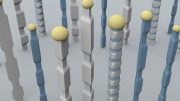
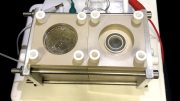

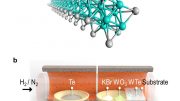
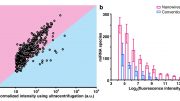
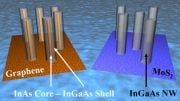


Be the first to comment on "Nanowire Innovation: Revolutionizing Fuel Cells With Enhanced Durability"